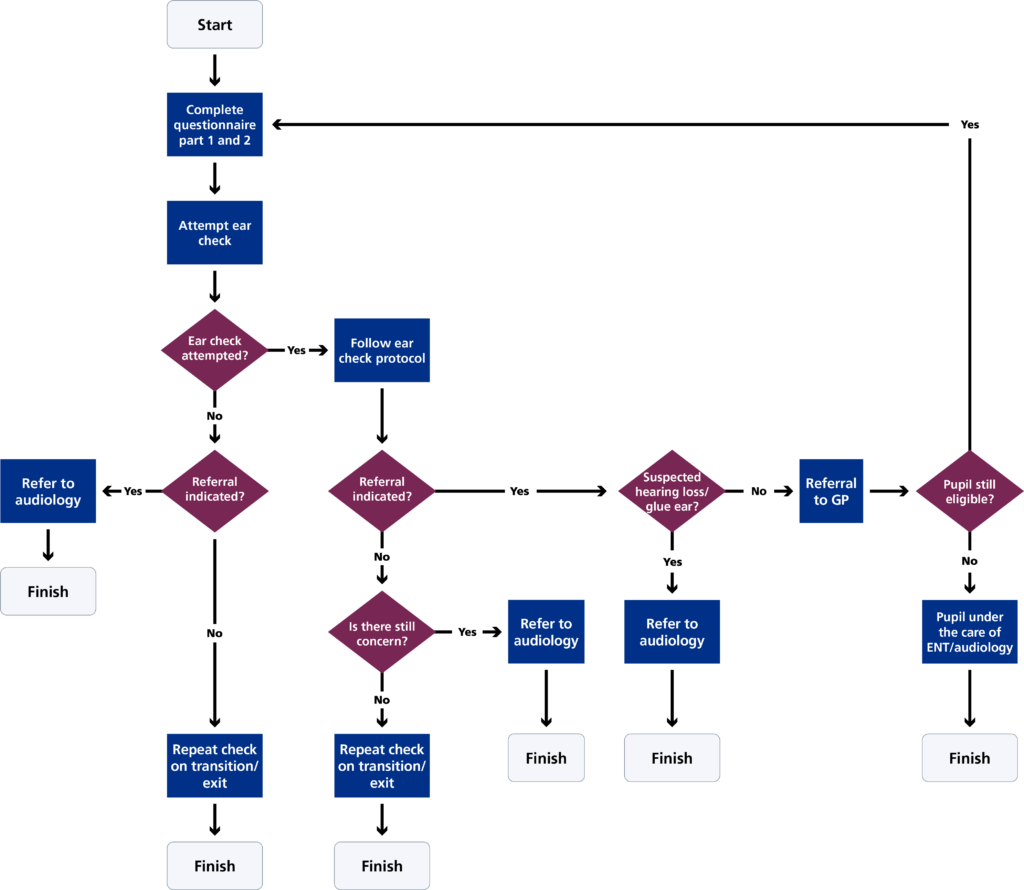Ear checks service process map – image

Ear checks service process map – PDF
Download the above process map as a PDF file.
Ear checks service process map – plain text
After assessing if the child is eligible for the ear check programme, complete the ear check questionnaire part 1 and part 2.
After ensuring personalised preparation and any reasonable adjustments needed, attempt the ear check following the ear check protocol (see clinical standards and local standard operating procedure (SOP)).
If the child does not accept the ear check, establish if a referral to audiology is indicated based on the ear check questionnaire and if there is concern about the child’s hearing or ear health. If a referral is indicated, refer to audiology. If a referral is not indicated, then the child will either finish the process or be re-checked again during their school career at recommended transition points or exit.
If the child accepts the ear check, establish if a referral is indicated.
If there is a clear response from the ear check, and no concern, then the child will either finish the process, or be re-checked again during their school career at recommended transition points or exit.
If a referral is indicated, establish if the ear check results indicate that the child may have hearing loss or glue ear.
If the check results indicate the child may have hearing loss or glue ear, refer to audiology. For any other issues, such as ear wax, or outer ear infection, refer the child to their GP.
Following their GP referral, establish if the child is now under the care of ear nose and throat (ENT), audiology or another medical speciality such as audiovestibular medicine. If the child is under the care of ENT or another medical specialty for an ear related issue, the child finishes the process, and exits the programme.
If the child has had their issue resolved, the child should have their ear health rechecked as part of the programme following the afore mentioned protocol to ensure underlying permanent hearing loss is not missed.
Written steps
1. Start here: begin the ear check process.
2. Complete ear check questionnaire part 1 and part 2: fill out part 1 preferences and part 2 auditory profile questionnaires.
3. Attempt ear check: perform the ear check on the pupil, following the clinical protocol.
4. Was the ear check accepted? did the child accept the ear check
- Yes- proceed to step 5 to determine if a referral is required
- No –is a referral indicated? determine if a referral is indicated based on the ear checks questionnaire and concern about the child’s hearing or ear health
- Yes: refer to audiology
- No: repeat check on transition or exit – finish
5. Referral indicated? determine if a referral to audiology is needed by following the clinical standards and local standard operating procedures (SOP)
- Yes: consider referral route- step 5
- No: is there still concern? determine if there are still concerns about the child’s hearing after the ear check
- Yes: refer to audiology
- No: repeat check on transition or exit – finish
6. Suspected hearing loss/glue ear?: Does the ear check indicate the child may have hearing loss or glue ear.
- Yes: refer to audiology and finish.
- No: other issue indicated, refer to GP
7. Pupil still eligible? check if the pupil is still eligible for the ear check after they have visited the GP.
- Yes: the Issue has been resolved; the child should have their ears checked again, re-entering the process.
- No: the child is under the care of ENT, audiology or a medical speciality for their ear or hearing related issue. Finish the process.
Publication reference: PRN01338viii

